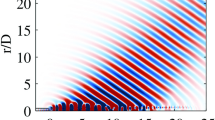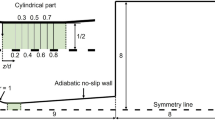Abstract
Detached-Eddy Simulations (DES) of flows over clean and controlled cavities with and without doors are presented in this paper. Mach and Reynolds numbers (based on cavity length) were 0.85 and one million respectively. Spectral analyses showed that the DES computations were able to correctly predict the frequencies of the Rossiter modes for both uncontrolled and controlled cases. Flow visualisations revealed that the impact of the shear layer formed along the cavity on a slanted aft wall no longer creates a large source of acoustic noise. Therefore little acoustic propagation was seen up the cavity. This was confirmed by the analysis of the cavity wall forces, which showed that the oscillations of the shear layer were reduced when the wall was slanted. This aided in reducing the overall Sound Pressure Levels throughout the cavity and far-field. Comparisons of the flow-fields suggested that the addition of the doors also aided in stabilising the shear layer, which was also shown in the analysis of the wall forces. As a result, the addition of the doors was found to affect the clean cavity configuration significantly more than the controlled one.
Similar content being viewed by others
References
Roshko, A.: Some measurements of flow in a rectangular cut-out. Technical Report, NACA Technical Report 3488, California Institute of Technology, August (1955)
Krishnamurty, K.: Acoustic radiation from two-dimensional rectangular cutouts in aerodynamic surfaces. Technical Report Technical Note 3487, National Advisor Committee For Aeronautics, August (1955)
Rossiter, J.E.: Wind tunnel experiments on the flow over rectangular cavities at subsonic and transonic speeds. Technical Report 64037, Royal Aircraft Establishment, October (1964)
Ross, J.A., Peto, J.W.: Internal stores carriage research at RAE. Technical Report 2233, Royal Aircraft Establishment, January (1992)
Ross, J.A.: Cavity acoustic measurements at high speeds. Technical Report DERA/MSS/MSFC2/TR000173, QinetiQ, March (2000)
Tracy, M.B., Plentovich, E.B.: Characterization of cavity flow fields using pressure data obtained in the Langley 0.3-meter transonic cryogenic tunnel. Technical Memorandum 4436, NASA, March (1993)
Rizzetta, D.P.: Numerical simulation of supersonic flow over a three-dimensional cavity. AIAA J. 26(7), 799–807 (1988)
Lawrie, D.: Investigation of cavity flows at low and high Reynolds numbers using computational fluid dynamics. PhD Thesis, University of Glasgow (2004)
Plentovich, E.B., Stallings, R.L. Jr., Tracy, M.B.: Experimental cavity pressure measurements at subsonic and transonic speeds. Technical Paper 3358, NASA (1993)
Cattafesta, L.N. III, Song, Q., Williams, D.R., Rowley, C.W., Alvi, F.S.: Active control of flow-induced cavity oscillations. Prog. Aerosp. Sci. 44(7–8), 479–502 (2008). doi:10.1016/j.paerosci.2008.07.002 (also AIAA-2003-3567)
Nightingale, D.A., Ross, J.A., Foster, G.W.: Cavity unsteady pressure measurements—examples from wind-tunnel tests. Technical Report Version 3, Aerodynamics & Aeromechanics Systems Group, QinetiQ, November (2005)
Badcock, K.J., Richards, B.E., Woodgate, M.A.: Elements of computational fluid dynamics on block structured grids using implicit solvers. Prog. Aerosp. Sci. 36(5–6), 351–392 (2000)
Nayyar, P., Barakos, G.N., Badcock, K.J.: Numerical study of transonic cavity flows using large-eddy and detached-eddy simulation. Aeronaut. J. 111(1117), 153–164 (2007)
Spalart, P.R., W-Jou, H., Strelets, M., Allmaras, S.R.: Comments on the feasibility of LES for wings, and on a hybrid RANS/LES aproach. In: Advances in DNS/LES, 1st AFOSR International Conference On DNS/LES, 4–8 August, Columbus, OH (1997)
Spalart, P.R., Allmaras, S.R.: A one-equation turbulence model for aerodynamic flows. Rech. Aerosp. 1, 5–1 (1994) (also paper AIAA-92-0439)
Nayyar, P.: CFD analysis of transonic turbulent cavity flows. PhD Thesis, University of Glasgow, August (2005)
Childers, D.G. (ed.): Modern Spectrum Analysis, chap. 2, pp. 23–148. IEEE, New York (1978)
Larchevêque, L., Sagaut, P., Lê, T.-H., Comte, P.: Large-eddy simulation of a compressible flow in a three-dimensional open cavity at high Reynolds number. J. Fluid Mech. 516, 265–301 (2004)
Pierce, A.D.: Acoustics: an Introduction to its Physical Principles and Applications. Acoustical Society of America, Woodbury, New York (1989)
Peng, S.-H., Leicher, S.: DES and hybrid RANS-LES modelling of unsteady pressure oscillations and flow features in a rectangular cavity. In: Notes on Numerical Fluid Mechanics—Advances in Hybrid RANS-LES Modelling, vol. 97, pp. 132–141. Springer, New York (2008)
Ashworth, R.M.: Prediction of acoustic resonance phenomena for weapons bays using detached eddy simulation. Aeronaut. J. 109(1102), 631–638 (2005)
Ashworth, R.: DES of a cavity with spoiler. In: Notes on Numerical Fluid Mechanics—Advances in Hybrid RANS-LES Modelling, vol. 97, pp. 162–171. Springer, New York (2008)
Lai, H., Luo, K.H.: A three-dimensional hybrid LES-acoustic analogy method for predicting open-cavity noise. J. Flow Turbul. Combust. 79(1), 55–82 (2007)
Larchevêque, L., Sagaut, P., Labbe, O.: Large-eddy simulation of a subsonic cavity flow including asymmetric three-dimensional effects. J. Fluid Mech. 577, 105–126 (2007)
Kegerise, M.A., Spina, E.F., Garg, S., Cattafesta , L.N. III: Mode-switching and nonlinear effects in compressible flow over a cavity. Phys. Fluids 16(3), 678–686 (2004)
Author information
Authors and Affiliations
Corresponding author
Rights and permissions
About this article
Cite this article
Barakos, G.N., Lawson, S.J., Steijl, R. et al. Numerical Simulations of High-Speed Turbulent Cavity Flows. Flow Turbulence Combust 83, 569–585 (2009). https://doi.org/10.1007/s10494-009-9207-1
Received:
Accepted:
Published:
Issue Date:
DOI: https://doi.org/10.1007/s10494-009-9207-1




